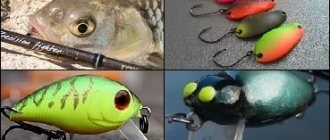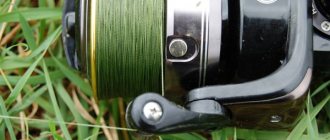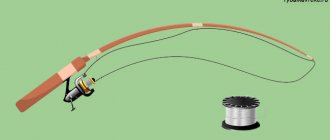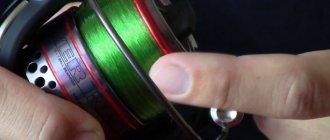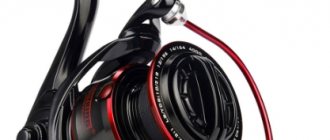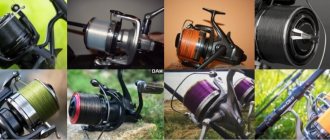A spinning reel is a complex and at the same time delicate mechanism that greatly simplifies fishing using spinning, match and Bolognese rods. The product consists of a certain number of parts that interact with each other through the transfer of energy from the rotation of the mechanism handle by the fisherman. The device facilitates winding and feeding of the cord, and also, through the brake, eliminates unnecessary loads that arise during the process of catching and retrieving the trophy.
Often, the reel operates under very unfavorable conditions due to exposure of product parts to water and contaminants from sand and dust, which affects the service life. There is no doubt that the mechanism requires maintenance and one of the main operations to prevent breakdowns and guarantee reliable operation is the lubrication of spinning reels. It is this important event for the device that will be discussed in the further material of the article.
Nuances of processing multiplier reels
Fishermen should pay attention to the maintenance of multiplier reels, which should be done more often and more thoroughly than inertia-free versions of mechanisms. Due to the design features, the multiplier parts are located in a housing that is easier for dirt and moisture to enter, which can significantly reduce the service life of the product.
Important! The choice of lubricant for a spinning reel of this type is based on compounds that are waterproof and do not dry out quickly.
In addition, the bearings must always contain an excess amount of lubricant to prevent moisture and abrasive from entering the part. It is not enough to lubricate a spinning reel once a season; the multiplier is inspected and checked for the presence of lubricants after each intensive fishing.
Care and prevention of breakdowns
During the fishing season, any mechanism is repeatedly exposed to harmful effects from excess moisture and sand entering the body, which destroys the working surfaces of interacting parts. It will not be possible to avoid these negative impacts even with the most scrupulous attitude towards the product. Prevention of breakdowns and care of the device consists of lubricating the mechanism and cleaning the internal and external surfaces of dirt.
To prevent the coil from failing, preventative maintenance must be performed at least once a year. After all, even an infrequently used mechanism is prone to natural drying of lubricants and corrosion of the metal surfaces of working parts and connecting elements that arise from the presence of moisture in the air.
Lubricant for fishing reels. How to choose?
The range of reel lubricants includes silicone, synthetic and mineral lubricants and oils.
To choose the right lubricant for a fishing reel, you need to know the device and the main construction materials from which the reel is made. For example, in plastic reels it is more advisable to use silicone or synthetic materials. Mineral lubricants can destroy plastic and rubber parts.
Oils are also not suitable for every reel assembly. Due to their low load-bearing capacity, it will quickly flow out of the bearings under the influence of centrifugal forces. Leaked grease can contaminate the entire interior of the reel, which will lead to painstaking cleaning at the next service.
Fishing reel lubricant must have the following properties:
- Be compatible with plastics, metals, rubbers
- Resistant to high and low temperatures
- Protect from moisture
- Do not wash with water
- Have no smell
- Ensure easy operation of coil units
Conventional mineral lubricants do not meet these requirements. As a rule, they have a smell that can scare away fish, they can destroy plastic parts, and leak from components at high temperatures. During the cold season, such lubricant thickens, disrupting the smooth operation of the reel, causing increased wear in the bearings, gears and worm gears of the reel.
When is lubrication needed?
In addition to the mandatory inspection and maintenance of reels before the start of a new fishing season, the mechanisms require emergency cleaning and lubrication when a number of situations arise that may subsequently negatively affect the performance of the product. This type of force majeure includes a long-term stay of the product in water, when there is a high probability of filling the case with moisture. Also, getting sand and dirt onto the working parts of the device and inside the body will not contribute to the correct operation of the reel on your next fishing trip.
You will also have to lubricate the spinning reel in cases where intensive fishing was carried out, involving forceful fishing of fish and frequent operation of the mechanism caused by the dynamics of the retrieves, especially heavy baits. Timely maintenance will keep the inertia-free unit in working condition for a longer period of time.
"Silicone Grease SI-180".
«
Silicone oil PMS 200″, etc. Pros:
1) They cost 20-30 rubles per tube, which is enough for 3-4 lubricants. 2) There are thick and very thick and medium and liquid and completely liquid. For every taste. 3) Inert. They do not interact with plastics, rubber or other crap. 4) Operating temperature - from minus 50 to plus 150. I have been lubricating the coil for the third year now, at first - with constant monitoring of the lubrication and gears. In the ability not to be displaced from working surfaces and in the smoothness of the ride compared to the branded Shimanovskaya, I did not find any difference only in prices! An example of one of the industrial silicone lubricants purely for bearings. Not bad either, IMHO of course. :
How to lubricate a spinning reel
In theory, ordinary machine oil and even solid oil can serve as a lubricant for coils, but in practice, to maintain optimal performance and ensure effective protection of the working surfaces of rubbing parts, it is better to use special lubricating compounds. These compounds are developed by reel manufacturers. Almost every brand has its own developments in lubricating compositions, which are offered for servicing the device upon purchase, which is worth using. In terms of consistency, lubricants can be liquid - for treating rotors and coil shafts, as well as thick - for lubricating gears and bearings.
One of the features of fishing reel lubrication is the versatility of certain types of compounds that are intended to treat the entire mechanism as a whole. Recently, effective silicone lubricants for inertia-free and multi-action machines have appeared on the market in the form of aerosols, which are much more convenient for servicing mechanisms.
Reel Lubricant
Test drive of SFT GREAS REEL SILICONE No. 1 lubricant
Recently, a wide range of lubricants and oils for SFT brand reels have appeared in our fishing stores. I read the manufacturer’s advertisement, watched the “promotional” video on the Internet
https://www.youtube.com/watch?v=mnawt_Xfl1g
I thought that they were deliberately trolling a domestic manufacturer who had finally decided to release high-quality (Teflon!!!) lubricants for premium class fishing reels (well, like IOS or ZPI) on our market.
And... I “bought it” anyway, ran to the store to buy this lubricant (in a red tube), and at the same time took the silicone liquid one.
On the back of the tube it honestly states that this is a miracle lubricant of PREMIUM quality - CIATIM221F, and on the front side of the tube it says SILICONE. Everything seems to be correct. CIATIM 221 (which according to GOST 9433-80) is made on the basis of organosilicon liquid.
He unscrewed the tube and squeezed it onto his finger. The consistency of the lubricant (compared to the “GOST” CIATIM 221) is noticeably looser, I would say “dry”, you definitely can’t spread it in a thin layer with a brush. I rubbed it between my fingers and my fingers remained “dry???”, they don’t even shine (you don’t have to wash your hands), there is no talk of any “stickiness”. And the smell, although not strong, is an obvious smell of petroleum products. CIATIM 221 doesn't smell like that! In principle, CIATIM 221 F is produced according to specifications, and not according to GOST, and the manufacturer could well have taken some “petroleum oil” as a basis, but then it is not CIATIM 221, but something completely different. GOST does not allow such a replacement. It was not possible to find real information about the composition of the lubricant on the Internet or on the manufacturer’s website, and this is a clear sign to wonder whether it is counterfeit.
As Kozma Prutkov said: “If you read the inscription on an elephant’s cage: buffalo, don’t believe your eyes.” And on the “elephant cage” (well, in the sense of CIATIM 221) it is written: “CIATIM-221F is a fluorinated version of CIATIM-221 lubricant.” Those. Ultrafine polytetrafluoroethylene (PTFE) was introduced into the CIATIM-221F lubricant.
As is known (for example, https://www.jerkbait.ru/index.php?option=com_content&task=view&id=401&Itemid=35): “Teflon (fluoroplastic) is a structural material that currently has the lowest coefficient of friction... . A Teflon film several microns thick that forms on the surface of the friction pairs sharply reduces the coefficient of friction...” Okay, I think, well, it’s “dry”, it’s not scary, there are also dry lubricants based on Teflon (https://forumshop.ru/suhaja-smazka-phorum-tovar.html), we need to do a test drive. I took my long-suffering Surf Master INFINITY, disassembled it, washed it in a galosh and lubricated it with this miracle lubricant. Also, I lubricated all the bearings (two on the main axis of the drive gear and one on the end of the line guide). I lubricated three bobbin bearings and the trim with liquid silicone (in the photo in a bottle).
Well, I think the reel will now spin like in this video
Collected, …. didn’t spin (….!!!).
The handle stroke became tight, with little load. When unwinding by hand, the idle speed of the handle is no more than 2 turns. The spool, when scrolled with a finger, turns half as much as with Tica liquid oil (included with Sculptor SL101). To be fair, it should be noted that the coil was practically silent. All the noise disappeared, the ride became very smooth. Of course, the slightly tight movement of the handle is not particularly annoying, BUT... where is the work beyond the slippery Teflon? Or is it not there, in the lubricant?
Yesterday evening I went out to test the reel at sea. The temperature in the evening dropped to 8-9 degrees. Rotating the handle, compared to a warm room, did not become tighter. I did not receive any additional positive emotions from the “tightly velvety” operation of the coil, and no negative emotions arose.
Now about the operation of the spool, lubricated with SFT liquid silicone, when casting.
The casting range of a drop-shot rig with a 14g sinker and a Rock Crow 2” has not changed; it still flies away at 85-90 turns of the handle. But what pleased me were two things. Firstly, the reel began to “forgive” sharper casts, i.e. There were no dashes, and even with unexpected gusts of wind, during the flight of the bait, there were no dashes either. Well, secondly, the sound of the bobbin bearings when casting has changed. Instead of “vzhzhzh...iiiik” (with teak oil) it became “frrr....” ))). In short, the spool began to work noticeably quieter when casting.
Conclusion:
1. Lubricant SFT GREAS REEL SILICONE No. 1 - “Fear the Danaans who bring gifts” (Virgil). I disassembled the coil, I will wash it and lubricate it again.
2. Well, SFT liquid silicone can be used to lubricate bobbin bearings in budget multiplier reels on medium and heavy weights or line rollers in budget meat grinders.
PS What I really didn’t like was that a dark coating appeared on the teeth of the gears of the main pair, and this was in just a couple of hours at sea!
How to disassemble a spinning reel
In order to disassemble the reel, the fisherman will need a certain plan of action and a small set of tools. Disassembly work is best done on a table covered with a clean sheet of white paper, on which the parts of the product are better visible. Good lighting is also necessary. The tools that will be in demand are: Phillips and flathead screwdrivers, tweezers, pliers, a brush, a large sewing needle, an old toothbrush and a household hair dryer. It’s also worth stocking up on pieces of soft cloth to wipe the parts and body from old grease and dirt. To wash the components of the device, you need to have kerosene or a small amount of gasoline.
Important! Disassembly is carried out with sequential unfolding according to the order of dismantling the removed parts - these actions will ensure error-free and accurate assembly of already serviced and lubricated elements.
Lubrication sequence
We begin the work slowly, remembering the order and principles of removing the components of the product. First, remove the handle and unscrew the clamp holding the spool. Next you need to remove the bushing with bearings and a set of adjusting washers. Having carried out this operation, they begin to dismantle the overrunning clutch. The removed parts are wiped with a cloth and cleared of debris using a needle, sequentially placing the elements of the mechanism on the table. Next, unscrew the anthers, also subjecting them to thorough cleaning of grains of sand and other contaminants. Now the fisherman has reached the heart of the mechanism, namely the gearbox itself. The box is removed from the body using tweezers.
Having marked with a marker the location of the gears relative to each other, we begin to remove them. We take out the carriage stopper and the carriage itself. We take out the axle and one of the gears of the main pair. After this manipulation, you can easily clean and lubricate all parts. After removing the remnants of old grease and visible blockages, the parts are washed in kerosene or gasoline, wiped with a cloth and dried with a hairdryer. After drying, lubricate and begin reassembling the device.
Grease is applied to the bearings and shafts during the direct connection of the mechanism elements. Experienced fishermen who have dealt with servicing reels more than once perform all the above operations within an hour. A beginner will need much more time and diligence to complete the work, and for accuracy of assembly, we recommend that you accompany the operations with photography to facilitate the reverse assembly process and eliminate installation errors.
Is it possible to lubricate the coil without completely disassembling it?
Beginning fishermen especially often wonder whether it is possible to lubricate a spinning reel without disassembling it. The question is relevant for a beginner, since each reel differs in the structure and design nuances of its assembly, and only a specialist can competently service the mechanism. But, unfortunately, it is worth noting that without opening the case and removing the component elements of the product, it is not possible to clean the mechanism and effectively service it.
Important! Aerosol sprays only partially relieve the lubrication problem, without eliminating the consequences of clogging of gears and gearbox shafts.
If a fisherman is unsure of his ability to properly service the device, the best option would be to trust the service departments or more experienced fishing colleagues in this matter, who perform the work efficiently and without loss of reel performance.
How to lubricate a spinning reel without disassembling
There are no videos or articles on the Internet about how to lubricate a spinning reel without disassembling it. This is because it is impossible to properly service the mechanism as a whole. It is important not just to lubricate the parts, but to evaluate their condition, clean, rinse, and dry. Only then will the lubricant have an effect and the device will last a long time.
Indiscriminate coil lubrication
A spray can be used as a temporary measure. You need to make sure that its interaction with the lubricant in the coil does not harm the parts. Compatibility information can be found on the spray packaging. But this does not relieve the fisherman from the need to disassemble and lubricate the device.
Just watch a video on lubricating a spinning reel to learn how to disassemble and maintain this device yourself. It is necessary to regularly inspect and clean the mechanism so that fishing is enjoyable and not a problem.

